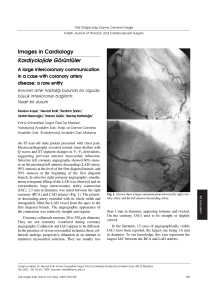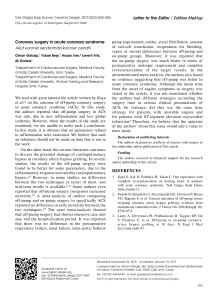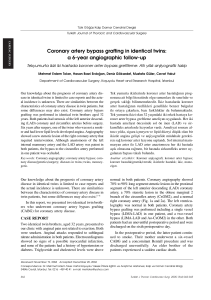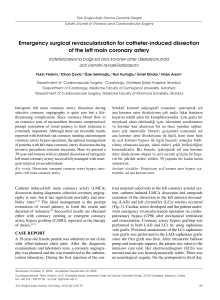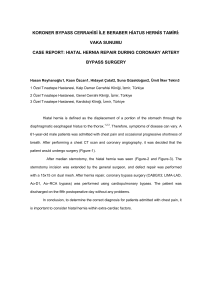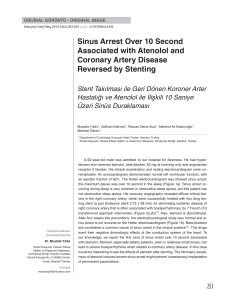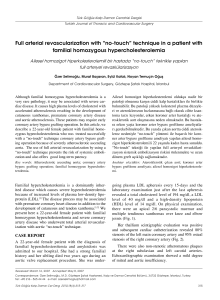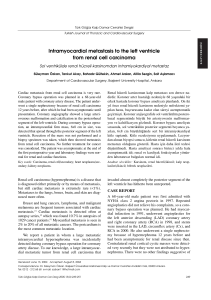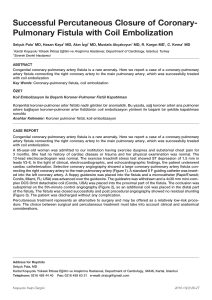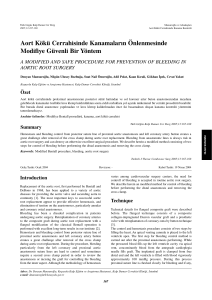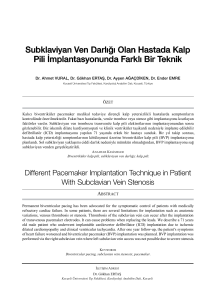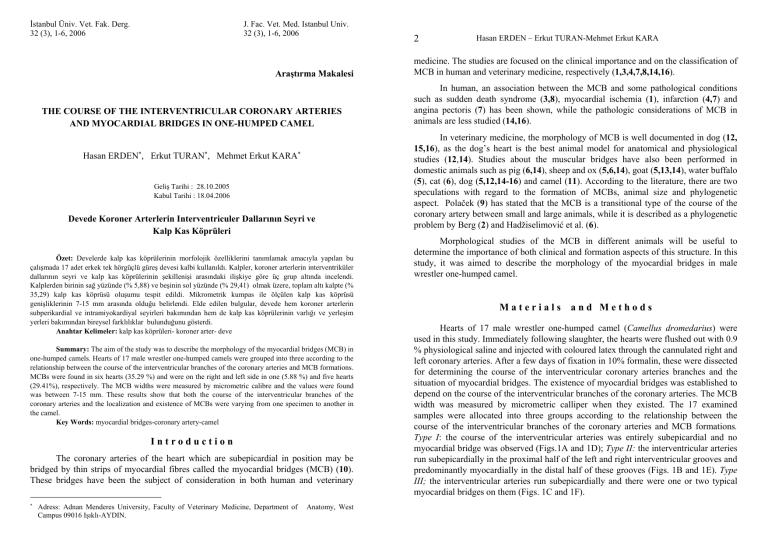
İstanbul Üniv. Vet. Fak. Derg.
32 (3), 1-6, 2006
J. Fac. Vet. Med. Istanbul Univ.
32 (3), 1-6, 2006
Araştırma Makalesi
THE COURSE OF THE INTERVENTRICULAR CORONARY ARTERIES
AND MYOCARDIAL BRIDGES IN ONE-HUMPED CAMEL
Hasan ERDEN∗, Erkut TURAN∗, Mehmet Erkut KARA∗
Geliş Tarihi : 28.10.2005
Kabul Tarihi : 18.04.2006
Devede Koroner Arterlerin Interventriculer Dallarının Seyri ve
Kalp Kas Köprüleri
Özet: Develerde kalp kas köprülerinin morfolojik özelliklerini tanımlamak amacıyla yapılan bu
çalışmada 17 adet erkek tek hörgüçlü güreş devesi kalbi kullanıldı. Kalpler, koroner arterlerin interventriküler
dallarının seyri ve kalp kas köprülerinin şekillenişi arasındaki ilişkiye göre üç grup altında incelendi.
Kalplerden birinin sağ yüzünde (% 5,88) ve beşinin sol yüzünde (% 29,41) olmak üzere, toplam altı kalpte (%
35,29) kalp kas köprüsü oluşumu tespit edildi. Mikrometrik kumpas ile ölçülen kalp kas köprüsü
genişliklerinin 7-15 mm arasında olduğu belirlendi. Elde edilen bulgular, devede hem koroner arterlerin
subperikardial ve intramiyokardiyal seyirleri bakımından hem de kalp kas köprülerinin varlığı ve yerleşim
yerleri bakımından bireysel farklılıklar bulunduğunu gösterdi.
Anahtar Kelimeler: kalp kas köprüleri- koroner arter- deve
Summary: The aim of the study was to describe the morphology of the myocardial bridges (MCB) in
one-humped camels. Hearts of 17 male wrestler one-humped camels were grouped into three according to the
relationship between the course of the interventricular branches of the coronary arteries and MCB formations.
MCBs were found in six hearts (35.29 %) and were on the right and left side in one (5.88 %) and five hearts
(29.41%), respectively. The MCB widths were measured by micrometric calibre and the values were found
was between 7-15 mm. These results show that both the course of the interventricular branches of the
coronary arteries and the localization and existence of MCBs were varying from one specimen to another in
the camel.
Key Words: myocardial bridges-coronary artery-camel
Introduction
The coronary arteries of the heart which are subepicardial in position may be
bridged by thin strips of myocardial fibres called the myocardial bridges (MCB) (10).
These bridges have been the subject of consideration in both human and veterinary
∗
Adress: Adnan Menderes University, Faculty of Veterinary Medicine, Department of
Campus 09016 Işıklı-AYDIN.
Anatomy, West
2
Hasan ERDEN – Erkut TURAN-Mehmet Erkut KARA
medicine. The studies are focused on the clinical importance and on the classification of
MCB in human and veterinary medicine, respectively (1,3,4,7,8,14,16).
In human, an association between the MCB and some pathological conditions
such as sudden death syndrome (3,8), myocardial ischemia (1), infarction (4,7) and
angina pectoris (7) has been shown, while the pathologic considerations of MCB in
animals are less studied (14,16).
In veterinary medicine, the morphology of MCB is well documented in dog (12,
15,16), as the dog’s heart is the best animal model for anatomical and physiological
studies (12,14). Studies about the muscular bridges have also been performed in
domestic animals such as pig (6,14), sheep and ox (5,6,14), goat (5,13,14), water buffalo
(5), cat (6), dog (5,12,14-16) and camel (11). According to the literature, there are two
speculations with regard to the formation of MCBs, animal size and phylogenetic
aspect. Polaček (9) has stated that the MCB is a transitional type of the course of the
coronary artery between small and large animals, while it is described as a phylogenetic
problem by Berg (2) and Hadžiselimović et al. (6).
Morphological studies of the MCB in different animals will be useful to
determine the importance of both clinical and formation aspects of this structure. In this
study, it was aimed to describe the morphology of the myocardial bridges in male
wrestler one-humped camel.
Materials
and Methods
Hearts of 17 male wrestler one-humped camel (Camellus dromedarius) were
used in this study. Immediately following slaughter, the hearts were flushed out with 0.9
% physiological saline and injected with coloured latex through the cannulated right and
left coronary arteries. After a few days of fixation in 10% formalin, these were dissected
for determining the course of the interventricular coronary arteries branches and the
situation of myocardial bridges. The existence of myocardial bridges was established to
depend on the course of the interventricular branches of the coronary arteries. The MCB
width was measured by micrometric calliper when they existed. The 17 examined
samples were allocated into three groups according to the relationship between the
course of the interventricular branches of the coronary arteries and MCB formations.
Type I: the course of the interventricular arteries was entirely subepicardial and no
myocardial bridge was observed (Figs.1A and 1D); Type II: the interventricular arteries
run subepicardially in the proximal half of the left and right interventricular grooves and
predominantly myocardially in the distal half of these grooves (Figs. 1B and 1E). Type
III; the interventricular arteries run subepicardially and there were one or two typical
myocardial bridges on them (Figs. 1C and 1F).
3
The Course of the Interventrıcular Coronary Arterıes and Myocardıal Brıdges
Table 1.
Types of the course of the interventricular arteries in each study sample. Interventricular
paraconal groove (Left side – L), interventricular subsinosal groove (Right side – R).
Çalışılan kalplerdeki interventrikuler arterlerin dağılımının tipleri. Sulcus interventricularis
paraconalis (Sol yüz – L), sulcus interventricularis subsinosus (Sağ yüz – R)
Tablo 1.
1
Type I
2
3
4
5
6
●
L
Type III
9
R
●
●
●
L
●
●
●
●
●
●
10
11
12
13
●
●
14
●
●
L
R
8
●
●
R
Type II
7
●
●
15
16
17
%
●
●
●
47.06
●
●
●
●
●
●
●
●
●
Hasan ERDEN – Erkut TURAN-Mehmet Erkut KARA
Myocardial bridges were found in six hearts (35.29 %) and were on the right and
left side in 1 (5.88 %) and 5 hearts (29.41%), respectively. In two hearts (11.76 %), two
myocardial bridges were observed on the interventricular paraconal branch. Myocardial
bridges were between 7-15 mm in width and were determined to be located at the level
of middle third of the interventricular grooves (Table 2).
17.65
●
●
4
23.53
●
●
76.47
29.41
Table 2. Widths of the determined myocardial bridges in each study sample. Left side (L), Right side (R).
Tablo 2. Çalışılan kalplerde tespit edilen kalp kas köprülerinin genişliği. Sol yüz (L), sağ yüz (R).
5.88
No of cases
To take attention to the MCB, the tone and contours of interventricular arteries
were sharpened in figure by using Adobe Photoshop 5.0.
L
1
Proximal
15mm
Distal
8mm
15mm
10mm
2
3
4
6
9
Proximal
10mm
Distal
10mm
15mm
R
-
7mm
-
-
Discussion
Figure 1. The course of the interventricular branches of the coronary arteries in both right
(upper) and left (lower) grooves. Type I (A and D), type II (B and E), type III (C and
F) and myocardial bridges (arrows).
Şekil 1. Koroner arterlerin interventricular dallarının dağılımı. Sulcus interventricularis
subsinosus (yukarıda) ve sulcus interventricularis paraconalis (aşağıda). Tip I (A ve
D), Tip II (B ve E), tip III (C ve F) ve miyocardial köprüler (oklar).
Results
The types of the course of the interventricular arteries in each examined sample
are shown in Table 1.
It was seen that almost half of the cases (47.06%) was type I on the left side, but
most of the cases (76.47%) was type II on the right side. Type I and II were observed in
both sides of the heart in 11.76 % and 23.53% of all cases, respectively.
Polaček (9) considered the behaviour of the coronary arteries in relation to the
myocardium to depend not so much on biological affinity as on the size of the animal.
There was an intramyocardial course in small animals as Rodentia and Insectivora and a
purely subepicardial course in large animals as Artiodactyla. The transitional type was
represented by muscular bridges in mammals owing to their sizes (sheep, goat, cat, dog)
(5,12,13). Contrary to this, it was reported that the behaviour of coronary arteries is a
phylogenetic problem and the arterial course does not depend on the animal size (2, 6).
Our findings showed that the behaviour of coronary arteries does not depend on animal
size. We observed three types of intramural course of the branches of the coronary
arteries in camels, as entirely subepicardial, predominantly intramyocardial, and
subepicardial and there was one or two typical myocardial bridges on the arteries.
In the fox, wild boar, pig, sheep, ox, domestic cat (6), dog (12) and goat (13) the
myocardial bridges are found on the left interventricular branch. Nevertheless, Dursun
et al. (5) reported that muscular bridges were observed on the right and left
interventricular branches in Akkaraman sheep, Angora goat, cattle, water buffalo and
dog. Van Nie and Vincent (14) examined the MCB in monkey, calf, sheep, goat, pig,
dog and seal and their results showed that most of the bridges are observed on the right
side. According to Taha and Abel-Magied (11) in the camel, the muscular bridges were
seen on the right interventricular branches in all cases and on the left interventricular
branches three hearts out of the ten. In the present study, MCBs were found in six hearts
The Course of the Interventrıcular Coronary Arterıes and Myocardıal Brıdges
5
out of the seventeen dissected (35.29 %). These muscular formations were on the right
or left side in one (5.88 %) and five hearts (29.41 %), respectively. In two hearts (11.76
%), two MCBs were observed on the interventricular paraconal branch. These variations
may depend on breed or individual differences.
Van Nie and Vincent (14) investigated that the myocardial bridge width in
different animals including monkey, calf, sheep, goat, pig, dog and seal, and found that
11.11 % of them was < 5 mm, 6-15 mm 55.56 % and 33.33 % was > 15 mm. These
authors stated also that bridge widths were dependent on the size of the heart. In this
study the MCB widths of 17 camels were between 7 and 15 mm.
In conclusion, these results show that the localization or existence of MCBs may
be independent from animal or heart size and are formed individually. Further studies
are required in a great number of different animal breeds, to determine whether the
MCB is related to the pathological conditions or not as in humans.
References
1.
Amitani, K., Yamaguchi, T., Takahashi, N., Uchida, T., Kushikata, Y., Munakata, K.,
Masuda, S., Orii, T.: Two cases of myocardial bridge associated with myocardial ischemia.
J. Nippon. Med. Sch. 2000; 67(3): 206-209.
2.
Berg, R.: Über das Auftreten von Myocardbrücken über den Koronargefässen beim Schwein
(Sus scrofa domesticus). Anat. Anz. 1963; 112: 25-31.
3.
Cutler, D., Wallace, J.M.: Myocardial bridging in a young patient with sudden death. Clin.
Cardiol. 1997; 20(6): 581-583.
4.
Diaz-Widmann, J., Cox, S.L., Roongsritong, C.: Unappreciable myocardial bridge causing
anterior myocardial infarction and postinfarction angina. South. Med. J. 2003; 96(4): 400402.
5.
Dursun N, Aştı RN, Tıpırdamaz S, Erden H, Çelik İ.: Macroscopic and microscopic
investigations on the myocardial bridges in domestic animals. S.Ü. Vet. Fak. Derg. 1992;
8(1): 12-17.
6.
Hadžiselimović, H., Šećerov, D., Gmaz-Nikulin, E.: Comparative anatomical
investigations on coronary arteries in wild and domestic animals. Acta Anat. 1974; 90(1): 1635.
7.
Kodama, K., Morioka, N., Hara, Y., Shigematsu, Y., Hamada, M., Hiwada, K.:
Coronary vasospasm at the site of myocardial bridge - report of two cases. Angiology. 1998;
49(8): 659-663.
8.
Morales, A.R., Romanelli, R., Boucek, R.J.: The mural left anterior descending coronary
artery, strenuous exercise and sudden death. Circulation. 1980; 62(2): 230-237.
9.
Polaček, P.: Über die myocardialen bündel, die den verlauf der koronararterien überbrücken.
Anat. Anz. 1959; 106(17-20): 386-395.
6
Hasan ERDEN – Erkut TURAN-Mehmet Erkut KARA
10. Schummer, A., Wilkens, H., Vollmerhaus, B., Habermehl, K.H.: The Circulatory System,
the Skin, and the Cutaneus Organs of the Domestic Mammals, Verlag Paul Parey, Berlin.
1981; 38.
11. Taha, A.A., Abel-Magied EM.: The coronary arteries of the Dromedary camel (Camelus
dromedarius). Anat. Histol. Embriyol. 1996; 25(4): 295-299.
12. Tangkawattana, P., Muto, M., Nakayama, T., Karkoura, A., Yamano, S., Yamaguchi,
M.: Prevalence, vasculature, and innervation of myocardial bridges in dogs. Am. J. Vet. Res.
1997; 58(11): 1209-1215.
13. Tıpırdamaz, S.: Comparative macronatomical study on heart and coronary arteries in
Akkaraman sheep and Angora goat. S.Ü. Vet. Fak. Derg. 1987; 3: 179-191.
14. van Nie, C.J., Vincent, J.G.: Myocardial bridges in animals. Anat. Histol. Embryol. 1989;
18(1): 45-51.
15. Yamaguchi, M., Tangkawattana, P., Karkoura, A., Takehana, K., Nakayama, T.,
Nakade, T., Muto, M., Sako, T., Masty, J., Wakao, Y.: Proximal paraconal
interventricular myocardial bridge in dog: ultrastructural characterization. Acta Anat. 1995;
153(3): 226-235.
16. Yamaguchi, M., Tangkawattana, P., Muto, M., Nakade, T., Taniyama, H., Miyata, Y.,
Nakayama, T., Hamlin, R.L.: Myocardial bridge muscle on left anterior descending
coronary artery differs from subepicardial myocardium of the left ventricle in dogs. Acta
Anat. 1996; 157(3): 238-247.

